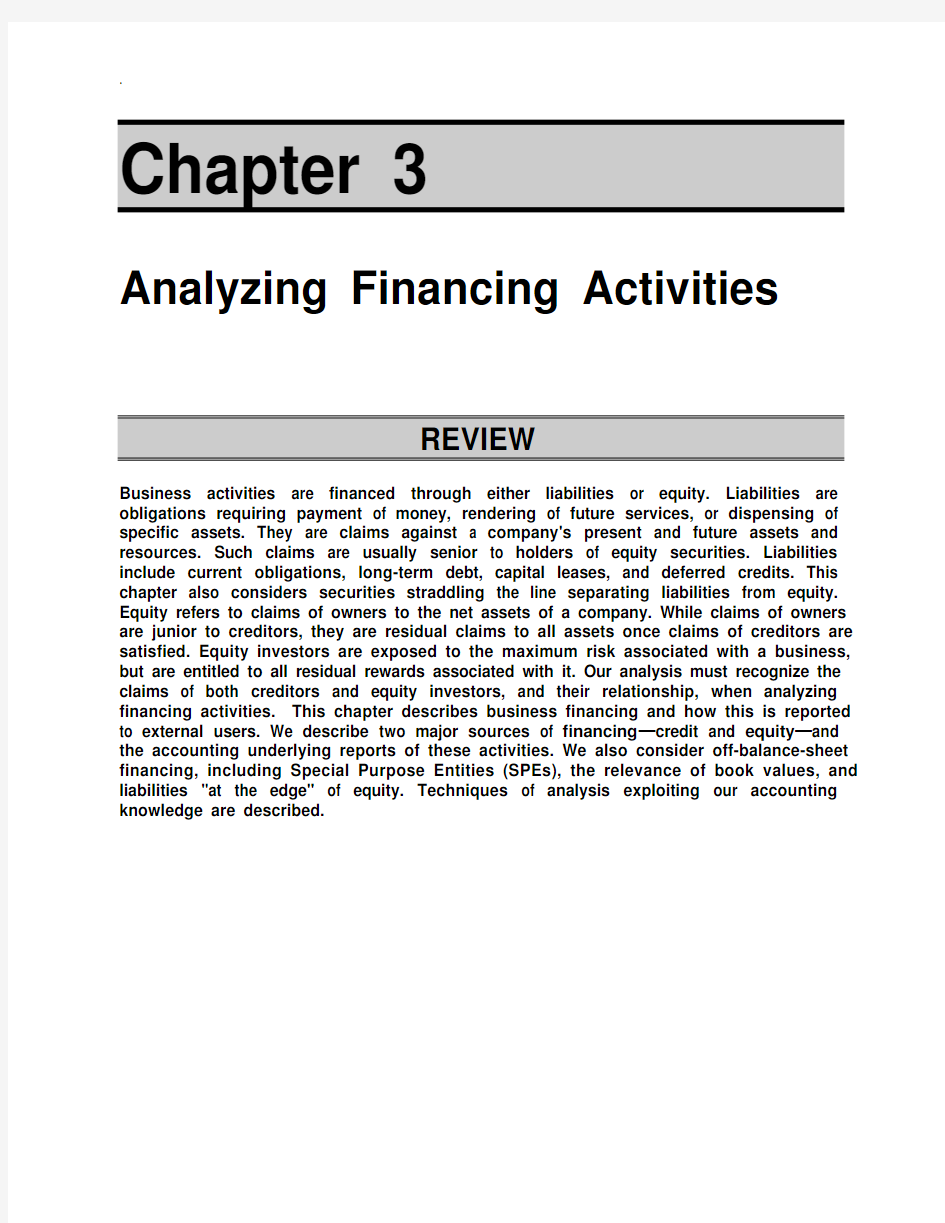
财务报表分析(英文版)答案
- 格式:doc
- 大小:706.50 KB
- 文档页数:74


Chapter 3
Analyzing Financing Activities
Business activities are financed through either liabilities or equity. Liabilities are obligations requiring payment of money, rendering of future services, or dispensing of specific assets. They are claims against a company's present and future assets and resources. Such claims are usually senior to holders of equity securities. Liabilities include current obligations, long-term debt, capital leases, and deferred credits. This chapter also considers securities straddling the line separating liabilities from equity. Equity refers to claims of owners to the net assets of a company. While claims of owners are junior to creditors, they are residual claims to all assets once claims of creditors are satisfied. Equity investors are exposed to the maximum risk associated with a business, but are entitled to all residual rewards associated with it. Our analysis must recognize the claims of both creditors and equity investors, and their relationship, when analyzing financing activities. This chapter describes business financing and how this is reported to external users. We describe two major sources of financing—credit and equity—and the accounting underlying reports of these activities. We also consider off-balance-sheet financing, including Special Purpose Entities (SPEs), the relevance of book values, and liabilities "at the edge" of equity. Techniques of analysis exploiting our accounting knowledge are described.
1. The two major source of liabilities, for both current and noncurrent liabilities, are
operating and financing activities. Current liabilities of an operating nature—such as accounts payable and operating expense accruals—represent claims on resources from operating activities. Current liabilities such as notes payable, bonds, and the current maturities of long-term debt reflect claims on resources from financing activities.
2. The major disclosure requirements (in SEC FRR, Section 203) for financing-related
current liabilities such as short-term debt are:
a. Footnote disclosure of compensating balance arrangements including those not
reduced to writing
b.Balance sheet segregation of (1) legally restricted compensating balances and (2)
unrestricted compensating balances relating to long-term borrowing arrangements if the compensating balance can be computed at a fixed amount at the balance sheet date.
c. Disclosure of short-term bank and commercial paper borrowings:
i. Commercial paper borrowings separately stated in the balance sheet.
ii. Average interest rate and terms separately stated for short-term bank and commercial paper borrowings at the balance sheet date.
iii. Average interest rate, average outstanding borrowings, and maximum month-end outstanding borrowings for short-term bank debt and commercial paper
combined for the period.
d. Disclosure of amounts and terms of unused lines of credit for short-term
borrowing arrangements (with amounts supporting commercial paper separately stated) and of unused commitments for long-term financing arrangements.
Note that the above disclosures are required for filings with the SEC but not necessarily for disclosures in published annual reports. It should also be noted that SFAS 6 states that certain short-term obligations should not necessarily be classified as current liabilities if the company intends to refinance them on a long-term basis and can demonstrate its ability to do so.
3. The conditions required by SFAS 6that demonstrate the ability of the company to
refinance it short-term debt on a long-term basis are:
a. The company has actually issued a long-term obligation or equity securities to
replace the short-term obligation after the date of the company's balance sheet but before its release.
b. The company has entered into an agreement with a bank or other source of capital
that permits the company to refinance the short-term obligation when it becomes due.
Note that financing agreements that are cancelable for violation of a provision that can be evaluated differently by the parties to the agreement (such as “a material adverse change” or “failure to maintain satisfactory operations”) do not meet the